Heliconius doris described in Papilio
Margarita Beltrán and Andrew V. Z. BrowerIntroduction
Heliconius doris populations are polymorphic in parts of the species distribution, with blue, red or green coloration at the base of the dorsal hindwing.

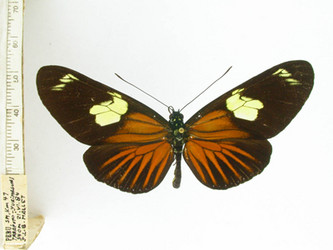
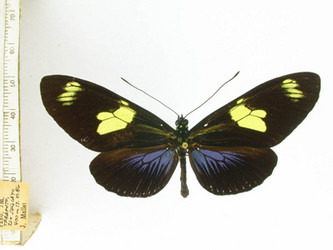
Laparus doris doris. Red morph on left, blue on right. ©
Etymology: DORIS was the Okeanid nymph wife of the sea-god Nereus, and the mother of the fifty Nereides. She may have been the goddess of the rich fishing-grounds found at the mouths of rivers where fresh water mingled with the brine. The Okeanides were sisters of the Rivers. Her name is connected with two words–dôron, "gift" or "bounty," and zôros, "pure" and "unmixed." Zôros was often used to describe fresh water and from it were derived words such as zôrua "a pipe for running water" and zôrux "a canal or water conduit" (Doris).
Characteristics
Early stages: Eggs are yellow and approximately 1.1 x 0.8 mm (h x w). Females gather together and usually each one places eggs to a total of 50 to 1000 in leaves of the host plant. Mature larvae have a yellow body with black bands and black scoli and head; length is approximately 0.1 cm. Caterpillars are gregarious (Brown, 1981).
Geographical Distribution
Heliconius doris is distributed from Central America to the Amazon. This map shows an approximate representation of the geographic distribution of this species. The original data used to draw these maps are derived from Brown (1979) which is available at Keith S. Brown Jr. (1979). Ecological Geography and Evolution in Neotropical Forests


Distribution of Heliconius doris (=Laparus doris). The range extends eastward beyond the pink area of the map, including Trinidad and the Guianas. © 2002 Margarita Beltran.
There are four named geographical races of H. doris (as well as numerous synonyms associated with the polymorphic populations):
- Heliconius doris doris (Linnaeus, 1771) (Papilio), widespread in Amazonia
- Heliconius doris dives (Oberthür, 1920) (Heliconia), Venezuela
- Heliconius doris obscurus Weymer, 1891, Colombia
- Heliconius doris viridis Staudinger, 1885, Central America
Habits
H. doris occurs from sea level to 1,800 m in forest clearings. Usually individuals fly rapidly and in the middlestory.
Larval hostplant: the gregarious larvae feed primarily on plants from the subgenus Granadilla, from the Quadrangulares, Digitales, and Laurifoliae sections (Passifloreaceae) (Brown, 1981)
References
Brower AVZ, and Egan MG. 1997. Cladistics of Heliconius butterflies and relatives (Nymphalidae: Heliconiiti): the phylogenetic position of Eueides based on sequences from mtDNA and a nuclear gene. Proc. R. Soc. Lond. B 264: 969-977.
Brown K. S. 1981 The Biology of Heliconius and Related Genera. Annual Review of Entomology 26, 427-456.
Doris. Theoi Greek Mythology. http://www.theoi.com/Nymphe/NympheDoris.html [Accessed Jul 16, 2008].
Linnaeus C. 1771 Regni animalis, Appendix. Insecta, pp. 529-543. In: Mantissa plantarum altera generum editionis VI & specierum editionis II. Holmiae, Laurentius Salvius. Pp. [i-vi], 143-588.
Penz CM. 1999. Higher level phylogeny for the passion-vine butterflies (Nymphalidae, Heliconiinae) based on early stage and adult morphology. Zoo. J. Linn. Soc. 127: 277-344.
Title Illustrations

| Scientific Name | Heliconius doris |
|---|---|
| Location | captive, Sophia M. Sachs Butterfly House in Chesterfield, Missouri, USA |
| Specimen Condition | Live Specimen |
| Identified By | Andrew V. Z. Brower |
| Behavior | Note the pollen being digested on the proboscis. |
| Sex | Female |
| Life Cycle Stage | adult |
| View | ventral |
| Source | Erato heliconian (Heliconius erato) |
| Source Collection | Flickr |
| Image Use |
 This media file is licensed under the Creative Commons Attribution-NonCommercial-ShareAlike License - Version 2.0. This media file is licensed under the Creative Commons Attribution-NonCommercial-ShareAlike License - Version 2.0.
|
| Copyright | © 2008 capnr0n |
| Scientific Name | Heliconius (Laparus) doris |
|---|---|
| Location | COLOMBIA: Cundinamarca, La Vega |
| Acknowledgements | used by permission, granted to AVZB 5/18/11 |
| Specimen Condition | Live Specimen |
| Identified By | Kim Garwood |
| Sex | Male |
| Life Cycle Stage | adult |
| View | dorsal |
| Source | Laparus doris |
| Source Collection | Flickr |
| Copyright | © 2010 Mike Chapman |
| Scientific Name | Laparus doris doris red |
|---|---|
| Specimen Condition | Dead Specimen |
| View | Ventral |
| Collection | Gerardo Lamas |
| Image Use |
 This media file is licensed under the Creative Commons Attribution-NonCommercial-ShareAlike License - Version 3.0. This media file is licensed under the Creative Commons Attribution-NonCommercial-ShareAlike License - Version 3.0.
|
| Copyright |
©

|
About This Page

University of Cambridge, Cambridge, UK

Middle Tennessee State University, Murfreesboro, Tennessee, USA
Correspondence regarding this page should be directed to Margarita Beltrán at and Andrew V. Z. Brower at
Page copyright © 2011 and
 Page: Tree of Life
Heliconius doris described in Papilio.
Authored by
Margarita Beltrán and Andrew V. Z. Brower.
The TEXT of this page is licensed under the
Creative Commons Attribution-NonCommercial-ShareAlike License - Version 3.0. Note that images and other media
featured on this page are each governed by their own license, and they may or may not be available
for reuse. Click on an image or a media link to access the media data window, which provides the
relevant licensing information. For the general terms and conditions of ToL material reuse and
redistribution, please see the Tree of Life Copyright
Policies.
Page: Tree of Life
Heliconius doris described in Papilio.
Authored by
Margarita Beltrán and Andrew V. Z. Brower.
The TEXT of this page is licensed under the
Creative Commons Attribution-NonCommercial-ShareAlike License - Version 3.0. Note that images and other media
featured on this page are each governed by their own license, and they may or may not be available
for reuse. Click on an image or a media link to access the media data window, which provides the
relevant licensing information. For the general terms and conditions of ToL material reuse and
redistribution, please see the Tree of Life Copyright
Policies.
- First online 18 February 2007
- Content changed 22 May 2011
Citing this page:
Beltrán, Margarita and Andrew V. Z. Brower. 2011. Heliconius doris described in Papilio. Version 22 May 2011 (under construction). http://tolweb.org/Heliconius_doris/72918/2011.05.22 in The Tree of Life Web Project, http://tolweb.org/




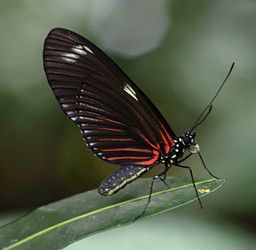
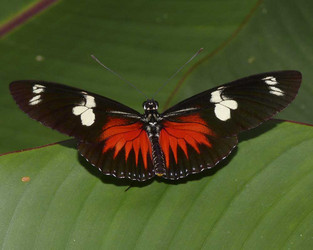
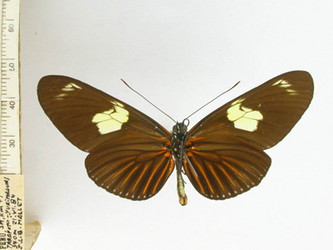

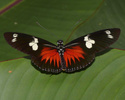



 Go to quick links
Go to quick search
Go to navigation for this section of the ToL site
Go to detailed links for the ToL site
Go to quick links
Go to quick search
Go to navigation for this section of the ToL site
Go to detailed links for the ToL site